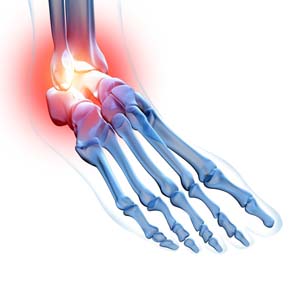Ankle Injury

What is an Ankle Injury?
Injuries to the ankle usually occur during sports activities, but you don’t have to be an athlete to hurt your ankle. It can happen to anyone, regardless of your age.
Anatomy of Your Ankle
The ankle is a complex joint that connects the leg with the foot and is composed of three bones: tibia, fibula and talus. It is involved in movement, providing stability and balance, and supporting the weight of your body. The joints of the ankle help you to walk or run, and to adapt to uneven ground. The ankle bones are held in place and supported by various soft tissues such as cartilage, ligaments, muscles, tendons and bursae. Injury to any of these parts can cause pain and disability.
Common Ankle Injuries
The most common injuries are ankle sprains, strains and fractures, where the ligaments, muscles and tendons, and bones are injured.
Causes of Ankle Injuries
An ankle injury can occur during sports activities or when you walk on uneven ground. Some of the common causes of ankle injuries may include:
- Wearing ill-fitting or high-heeled shoes
- Falling, tripping or twisting your ankle
- Landing awkwardly after a jump
- Following an accident
Symptoms of Ankle Injuries
The most common symptoms of ankle injuries are:
- Pain
- Bruising
- Swelling
- Inability to bear weight on your foot or walk
Diagnosis of an Ankle Injury
Your doctor will diagnose an ankle injury by reviewing your symptoms, performing a thorough physical examination and ordering imaging tests such as X-rays and MRI scan.
Treatments for an Ankle Injury
Most ankle injuries can be treated with pain medication and anti-inflammatory drugs. Further treatment will depend on the type of injury.
Fractures are treated with nonsurgical or surgical reduction, where the broken pieces of bone are placed together and allowed to heal in the normal alignment.
Ankle sprains are treated with rest, ice, compression and elevation (RICE). You may have to wear a brace or splint to reduce motion of the ankle. Anti-inflammatory pain medications may be prescribed to help reduce the pain and control inflammation.
The treatment of ankle strains are similar to ankle sprains and may include pain and anti-inflammatory medication, immobilization with a cast or splint, physical therapy and surgery to repair torn tendons.
Prevention of Ankle Injuries
Ankle injuries can be prevented by the following ways:
- Wear well-fitting shoes.
- Avoid running on uneven ground.
- Listen to your body and take a break from your exercise or sports when in pain or tired.
- Maintain proper conditioning of the sport you play.
- Warm up before sports or exercises.
- Wear the right equipment for your sport.








